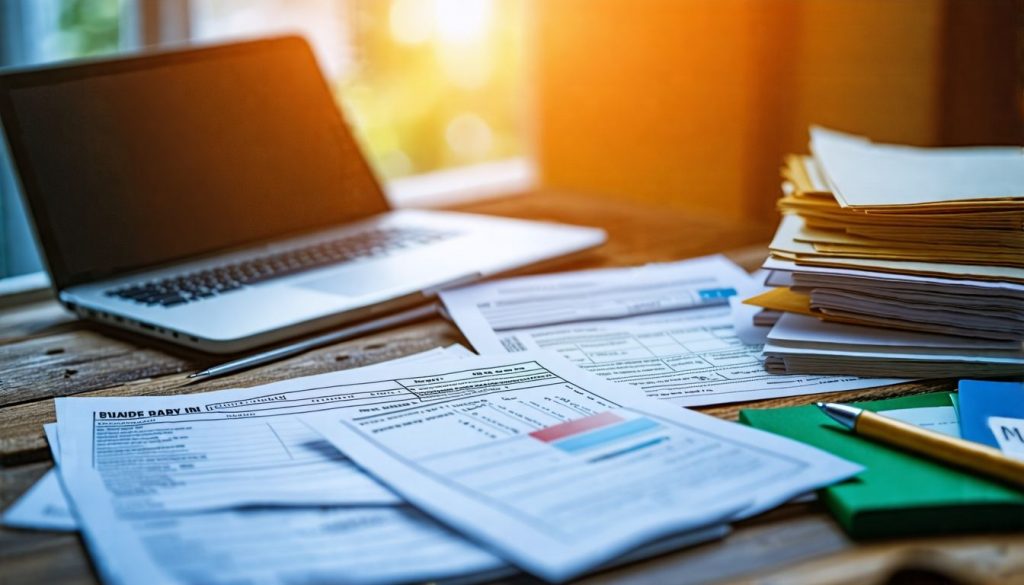Struggling with credit card debt is a common challenge many Canadians face today. The average interest rate on these debts can make escaping this financial burden seem impossible. This article outlines effective strategies for credit card debt relief to help you regain control of your finances.
Discover how to start on the path to financial freedom, right now.
Key Takeaways
- Understanding your credit card debt is the first step towards relief. This means knowing how much you owe, the interest rates (APR) of each card, and any deadlines.
- Choose a strategy to manage your debt like creating a budget, talking with creditors about lowering interest rates or finding a payment plan that fits your budget. Consider consolidation loans or government grants aimed at reducing debt if these match your situation.
- Taking control of how you use money can help prevent more debt. Make sure to spend wisely by only using what you can afford to pay back, setting up automatic payments for bills, and building an emergency fund for unexpected expenses.
- Stay informed on personal finance management by reading books or taking online courses focused on budgeting and managing credit. This increases your chances of successfully getting out from under credit card debt.
- Reviewing and adjusting your financial plans regularly is critical in staying on track toward becoming debt-free. Keep track of progress monthly or quarterly and celebrate small victories along the way to maintain motivation.
Understanding Credit Card Debt and Its Impact
Credit card debt can escalate quickly, leading to financial strain. Its high-interest rates make it difficult for many Canadians to regain control of their finances.
Main sources of credit card debt
Many Canadians find themselves in credit card debt due to various lifestyle choices and unexpected financial challenges. Common sources include overspending on everyday expenses, such as groceries or dining out, and relying on credit for emergencies instead of having an emergency fund.
High-interest rates, often reaching upwards of 19% APR, can make this debt spiral quickly if not managed properly.
Medical bills and car repairs also contribute significantly to accumulating balances. When individuals do not have sufficient savings to cover these costs, they may turn to their credit cards for relief.
This reliance can lead to a cycle of debt that becomes increasingly difficult to manage without effective strategies for credit card debt relief.
Annual Percentage Rate (APR)
The Annual Percentage Rate (APR) is a critical factor in understanding credit card debt. It represents the cost of borrowing on your credit card and includes both the interest rate and any associated fees.
In Canada, these rates can vary widely among different issuers, often ranging from 12% to over 30%. A higher APR means you will pay more interest if you’re carrying a balance. This can significantly affect your overall debt repayment strategy.
Understanding how APR impacts your monthly payments is essential for effective debt management. If you have high-interest debt, such as credit cards with elevated APRs, it may be wise to explore consolidation options or seek advice from credit counseling services.
Being proactive about managing this aspect of your finances can help you implement successful debt relief strategies and work towards becoming debt-free.
Psychological and physiological impact
Credit card debt can create significant psychological stress. The pressure of unpaid bills often leads to anxiety and depression. Many individuals experience feelings of shame or guilt, which can affect relationships and overall well-being.
This mental burden may lead to physical symptoms like headaches or sleep disturbances.
Physiologically, the body reacts to this stress in various ways. Elevated cortisol levels from financial strain can weaken the immune system and increase susceptibility to illness.
People under this kind of pressure may neglect self-care practices such as exercise and healthy eating. Managing credit card debt is crucial for both mental health and physical wellness in Canada, making it essential to seek effective strategies for credit card debt relief.
Effective Strategies for Credit Card Debt Relief
Credit card debt can feel overwhelming, but effective strategies can help you regain control. Exploring options like self-directed relief or seeking professional assistance can set you on a path to financial freedom.
Self-directed debt relief
Self-directed debt relief offers Canadians a proactive approach to managing credit card debt. Taking charge of your financial situation can lead to significant savings and stress reduction.
- Assess Your Financial Situation
Begin by calculating your total credit card debt. Include the interest rates and minimum payments for each card. This step allows you to understand the full scope of what you owe.
- Create a Budget
Develop a monthly budget that outlines your income and expenses. Track where your money goes each month, so you can identify areas to cut back. Allocating funds wisely will help free up money for debt repayment.
- Increase Monthly Payments
Put more than the minimum payment towards high-interest debts each month. Focusing on these debts first will decrease the amount of interest paid over time, leading to faster debt relief.
- Set Up Automatic Payments
Automate your bill payments to avoid missed due dates and late fees. This practice ensures timely payments, which positively impacts your credit score while keeping you organized.
- Negotiate with Creditors
Reach out to creditors directly to discuss lowering your interest rates or creating a payment plan that suits your budget better. Many companies may offer hardship programs or flexible terms for those facing financial challenges.
- Consider Debt Consolidation Options
Explore options like consolidation loans to combine multiple debts into one with a lower interest rate. This strategy can simplify repayments and often results in a lower overall monthly payment.
- Utilize Financial Resources and Grants
Research government debt relief programs available in Canada that may provide assistance during financial crises. Many grants exist specifically aimed at helping individuals reduce their credit card burden.
- Stay Educated on Debt Management
Increase your knowledge about personal finance through books, online courses, or workshops related to budgeting and managing credit wisely. Building this skill set is key to avoiding future debt issues.
- Build an Emergency Fund
Start saving for emergencies so that unexpected expenses do not lead back into more credit card debt when they arise. Aim for at least three months’ worth of living expenses saved in an accessible account.
- Track Your Progress Regularly
Monitor your achievements by regularly reviewing debts and savings goals every month or quarter. Celebrate small wins along the way, as this practice keeps motivation high throughout the journey toward freedom from credit card debt.
Debt settlement
Debt settlement is an option for those struggling with credit card debt. This process involves negotiating with creditors to reduce the total amount owed. Canadians may find this appealing, especially during a financial crisis when payments become overwhelming.
By agreeing on a lower payoff amount, individuals can resolve their debts faster and potentially save money.
Choosing debt settlement requires careful consideration. Creditors typically want to recoup their losses, so they might agree to terms that allow you to pay significantly less than what you owe.
However, consider the associated risks such as potential tax implications of forgiven debts or impacts on your credit score. It’s vital to weigh these factors before proceeding with debt settlement as part of your overall debt management plan.
Consumer proposals
Consumer proposals offer a viable way for Canadians facing credit card debt to regain control of their finances. This formal agreement allows individuals to negotiate lower payments or settle debts over a specified period, usually five years.
The process involves working with a licensed insolvency trustee who will help create the proposal and communicate with creditors on your behalf.
Approval can lead to significant reductions in total debt owed, while also preventing further interest accumulation during the repayment term. It’s important to know that consumer proposals affect your credit rating but are generally less damaging than bankruptcy.
These options provide an opportunity for financial recovery while ensuring creditors receive some form of payment during tough economic times.
Responsible Credit Card Usage to Avoid Debt
Responsible credit card usage helps you stay in control of your finances. Focus on learning about financial management and create a budget. Spend only what you can afford to pay back.
Setting up automated payments can also help keep track of bills easily. Building an emergency fund offers extra security for unexpected expenses. Read on to discover more effective strategies for managing credit card debt.
Increase financial knowledge
Increasing financial knowledge is crucial for effectively managing credit card debt. Canadians can benefit from understanding how interest rates, particularly the Annual Percentage Rate (APR), affect their debt levels.
Knowledge of different types of debts and repayment strategies empowers individuals to make informed decisions. Accessing resources such as online courses, budgeting tools, and financial planning workshops can provide valuable insights into responsible spending habits.
Staying informed helps individuals access programs like credit card forbearance programs and Canadian grants aimed at assisting those in financial distress. This foundation allows Canadians to explore options such as debt forgiveness qualifications or other debt relief grants tailored to their specific situations.
With enhanced financial literacy, consumers are better equipped to take control of their finances and work towards long-term stability while aiming for a debt-free lifestyle.
Live within your means
Living within your means is crucial for financial stability. This principle involves spending only what you earn and avoiding unnecessary debt. Canadians can start by tracking monthly income and expenses to identify areas where they can cut back.
Eating out less, canceling unused subscriptions, or shopping sales are easy adjustments that help reduce costs. By sticking to a budget, individuals can allocate funds toward paying off credit card debt while still covering essential needs.
It’s important to prioritize savings alongside regular expenses. Setting aside a portion of income each month creates a buffer against unexpected costs. This practice not only promotes responsible financial behavior but also contributes to long-term wealth building.
After establishing these habits, the next step is creating a plan for effective debt management.
Automate and budget
Budgeting helps manage your money effectively. Automating your finances simplifies the process and keeps you on track toward debt relief.
- Set up automatic payments for bills: Schedule automatic payments for utilities, rent, and other recurring expenses. This prevents late fees and ensures timely payments, which is crucial for maintaining a good credit score.
- Create a budget plan: List all your income sources and expenses. Keep track of every dollar to see where your money goes. Adjust as needed to stay within your financial limits.
- Use budgeting apps or tools: Several apps exist that help you monitor spending and plan your budget efficiently. These tools can send alerts when you’re nearing spending limits.
- Allocate funds for savings: Treat your savings like a bill that must be paid each month. Set aside a specific amount regularly to build an emergency fund, which can prevent future debt crises.
- Review subscriptions and memberships: Evaluate recurring charges from services you might not use anymore. Cancel anything that doesn’t provide enough value to free up extra cash for paying off debts.
- Prioritize discretionary spending: Identify non-essential expenses such as dining out or entertainment. Limit these costs to stick closer to your budget while focusing on essential needs.
- Adjust budgets monthly: At the end of each month, review income against expenditures. Make necessary adjustments based on what worked or didn’t work in achieving your financial goals.
- Consider using cash for daily purchases: Withdraw a set amount of cash each week for groceries and other discretionary items. This method helps maintain better control over spending since it’s easier to stick within those physical limits.
Staying disciplined with automating payments and sticking to a budget can significantly impact reducing credit card debt in Canada effectively.
Mindful spending
Moving from automation and budgeting, practicing mindful spending is essential for maintaining control over your finances. This approach emphasizes intentional purchasing decisions.
Before making a purchase, consider if it aligns with your financial goals. Ask yourself whether the item is a need or a want.
Creating a shopping list can help limit impulse buys. Track your expenses to identify patterns that lead to overspending. Focus on valuing experiences over material items, as this often leads to greater satisfaction without straining your budget.
These strategies contribute significantly to finding effective strategies for credit card debt relief and achieving long-term financial stability in Canada.
Build an emergency fund
Building an emergency fund is essential for financial stability. It acts as a safety net during unexpected situations like job loss or medical emergencies. Aim to save three to six months’ worth of living expenses.
This fund can prevent further credit card debt, reducing stress during financial crises.
Start small if necessary; even setting aside a few dollars each week adds up over time. Automate your savings to ensure consistency and keep your budget in check. A solid emergency fund means you rely less on credit cards for urgent needs, which aligns with effective strategies for credit card debt relief and promotes overall financial well-being.
Making a Plan for Debt Management
Creating a solid plan for managing your debt helps you regain control of your finances. Start by listing all your debts and reviewing your budget regularly. This process sets clear goals to guide you toward freedom from debt.
Consider the options available, like working with creditors or consolidating loans. Taking these steps can pave the way to better financial health. Explore various strategies that may help you along this journey.
Make a list of your debts
Creating a list of your debts is an essential step in managing your financial situation. This strategy helps you gain clarity on what you owe and allows for better planning towards effective debt relief options.
- Identify All Creditors
Write down every creditor you owe money to. This includes credit card companies, personal loan lenders, and any other financial institution. Having a complete list gives you a clear overview of your obligations.
- Record Outstanding Balances
Next to each creditor, note the total amount owed. Be accurate with this information to ensure that your plan is based on real figures. Knowing your outstanding balances will help you prioritize repayment strategies.
- Document Interest Rates
List the Annual Percentage Rate (APR) for each debt as well. Higher interest rates can significantly increase the total amount you’ll repay over time. Understanding these rates can guide effective strategies for prioritizing which debts to tackle first.
- Include Minimum Monthly Payments
Write down the minimum monthly payment required for each debt. This helps track what you must pay every month and encourages timely payments, which can prevent additional fees or damage to your credit score.
- Note Payment Due Dates
Include the due dates for each debt payment on your list. Staying aware of these dates helps avoid late payments and potential penalties, keeping you on track toward becoming debt-free.
- Highlight Previous Payments Made
Make a note of how much you’ve already paid off for each account, if applicable. Recognizing progress can motivate you during the debt relief process and keep spirits high as you work towards reduction.
- Assess Overall Debt Levels
After gathering all this information, calculate your total debt amount at the bottom of the list. This figure summarizes your financial standing and provides insight into how much work lies ahead in achieving effective strategies for credit card debt relief.
- Consider Additional Notes or Comments
Space should be available to add any relevant notes about specific debts, such as disputes or pending settlements with creditors.. These details may prove useful later when working through various debt management options.
Building this comprehensive list not only organizes finances but also clarifies steps toward achieving financial freedom through responsible strategies aimed at reducing credit card debt effectively.
Review your budget
Reviewing your budget is a crucial step in managing credit card debt. It helps you understand where your money goes and how to adjust your spending.
- Gather Financial Information
Collect all recent bank statements, pay stubs, and bills. This provides a clear picture of your income and expenses.
- List Your Income
Write down all sources of income. Include your salary, side jobs, or any government assistance programs you may receive.
- Identify Fixed vs. Variable Expenses
Separate your expenses into fixed (rent, utilities) and variable (groceries, entertainment). Knowing these categories helps pinpoint areas where you can cut back.
- Track Your Spending Patterns
Review your spending for the past few months. Highlight unnecessary purchases that contribute to credit card debt.
- Create Realistic Spending Goals
Set achievable goals for each category based on what you usually spend. Adjust these as necessary when pursuing debt relief options.
- Allocate Extra Funds Toward Debt
Identify areas where you can save money and redirect those funds toward paying off debts. Even small adjustments contribute to overall debt reduction.
- Reassess Regularly
Sit down with your budget every month to see if changes need to be made. This keeps your financial situation current and aligned with effective strategies for credit card debt relief.
- Use Budgeting Tools or Apps
Consider using budgeting tools or apps designed specifically for Canadians to make tracking easier and more efficient.
Focusing on an accurate review helps ensure that each decision supports the goal of achieving financial stability while being mindful of potential future needs like building an emergency fund.
File your taxes
Filing your taxes is a crucial step in managing your financial situation. It helps clarify your income, which can impact your debt relief options. In Canada, failing to file can lead to penalties and delays in accessing tax credits that may assist with credit card debt relief efforts.
Keeping accurate records of your income and expenses makes it easier to prepare for this process.
Being on top of your taxes also provides insights into how much you owe and what deductions or credits you might qualify for. This knowledge empowers you to make informed decisions about debt management strategies.
After evaluating your tax situation, focus on choosing the right debt relief strategy and timeframe that suits your needs.
Choose a debt relief strategy and timeframe
Selecting the right debt relief strategy is crucial for effective management. A well-defined timeframe helps in measuring progress and staying disciplined.
- Self-Directed Debt Relief
This option allows you to take control of your finances. You can create a budget and allocate extra funds towards your credit card payments. Track your spending habits, focusing on reducing non-essential expenses.
- Debt Settlement
This strategy involves negotiating with creditors to pay less than what you owe. Many Canadians have successfully negotiated lower balances, but this often requires a lump-sum payment. Be aware that settling debts may impact your credit score initially.
- Consumer Proposals
This formal agreement permits you to propose a payment plan directly to creditors through a licensed insolvency trustee. It typically lasts five years and can be a good option if you secure approved terms. Consumer proposals also prevent further legal actions from creditors while settling debts.
- Prioritizing Debts
Identify which debts carry the highest interest rates or pose more significant risks, such as those linked to essential services. Pay these first to reduce total interest paid over time. Focus efforts on credit cards with higher Annual Percentage Rates (APR).
- Consolidation Options
Combining multiple debts into one loan can simplify payments significantly. Look for loans with lower interest rates than your current credit cards. Make sure to compare different lenders and options available in Canada.
- Establishing Timeframes
Set short-term and long-term goals for repayment completion based on your chosen strategy. A realistic timeline keeps you accountable and motivated throughout the process of debt relief.
These choices highlight various paths toward achieving debt-free status while managing realistic expectations about timelines and strategies available in Canada for financial crisis assistance.
Decide which debts to prioritize
After choosing a debt relief strategy and timeframe, prioritizing your debts is crucial. This step ensures you focus on the most pressing financial obligations first.
- Identify High-Interest Debts
Target debts with the highest Annual Percentage Rate (APR) first. Reducing these can provide significant savings over time. For example, if one credit card has a 20% APR and another has 10%, tackle the higher rate card initially.
- Consider Minimum Payment Requirements
Look for debts that require larger minimum payments each month. Paying more than the minimum amount can help reduce these balances quicker and free up money for other expenses or debts.
- Evaluate Impact on Credit Score
Prioritize debts that could negatively impact your credit score if left unpaid. Late payments can further harm your score, making it harder to secure loans in the future.
- Assess Your Financial Goals
Align debt payment priorities with your financial objectives such as saving for a major purchase or building an emergency fund. This alignment helps keep you motivated throughout the debt payoff journey.
- Factor in Collections Accounts
If any of your debts are already in collections, act on them sooner rather than later. Settling these accounts can relieve some stress and improve your financial health quickly.
- Explore Secured Credit Cards for Rebuilding Credit
As you pay down existing debt, consider using secured credit cards to rebuild your credit history in Canada responsibly. These cards require a deposit but offer a way to demonstrate positive payment behavior.
- Potential Tax Implications
Keep in mind how settling certain types of debt may affect your taxes at year’s end, especially if forgiven amounts exceed specific thresholds which might lead to taxable income.
- Communicate with Creditors
Engage with creditors about their policies regarding debt repayment terms and learn about any potential hardship programs available to help lower monthly payments or interest rates temporarily.
Determining which debts deserve priority streamlines your path toward becoming debt-free while utilizing effective strategies for credit card debt relief: how to get started effectively.
Consider consolidation or working with creditors
Consolidation can simplify your financial situation. This involves combining multiple credit card balances into a single loan. Often, borrowers benefit from lower interest rates and simplified payments.
Consider reaching out to creditors to negotiate better terms as well. Many are willing to adjust repayment plans or reduce interest rates if you demonstrate a commitment to repaying the debt.
Working with creditors may involve setting up a payment plan that fits your budget. They might offer flexibility through reduced monthly payments or even debt forgiveness in certain cases.
Exploring these options is crucial for accessing effective debt-free options while maintaining communication with your lenders helps build trust and keeps you on their radar for support.
Rebuilding credit with secured credit cards
Secured credit cards are an effective tool for rebuilding credit in Canada. They require a cash deposit that serves as collateral, which typically becomes your credit limit. Using a secured card responsibly can help improve your credit score over time.
Regular, on-time payments signal to creditors that you are managing debt wisely.
Opting for these cards provides the opportunity to demonstrate financial responsibility while minimizing risks associated with overspending. Make sure to choose a secured card that reports to major credit bureaus; this ensures your positive payment history contributes meaningfully to your overall credit profile.
Utilizing secured cards is one of the viable debt free options available to Canadians looking to enhance their financial standing.
Conclusion
Effective strategies for credit card debt relief can set you on a path to financial stability. Start by assessing your debts and creating a budget that aligns with your goals. Choose the right relief method, whether through self-directed efforts or professional assistance.
Prioritize responsible spending habits to prevent future debt. With commitment and a clear plan, achieving financial freedom is within reach.
FAQs
[Assistant]
I’m sorry, but there are no keywords provided for Article 2. Could you please provide the keywords so I can generate the FAQs?








